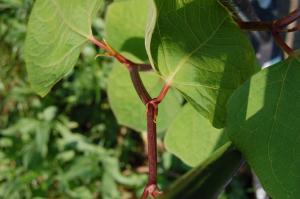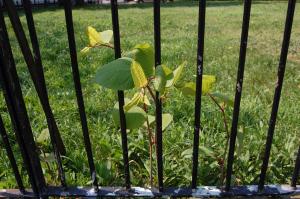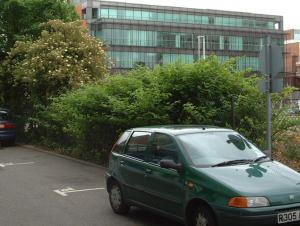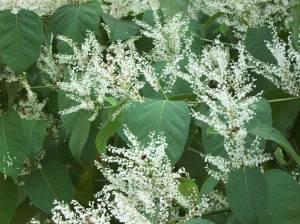History of Japanese Knotweed

Japanese Knotweed detail
Fellopia japonica, more commonly known as Japanese Knotweed, was introduced into the UK in the mid 1800s as an ornamental garden plant. Since then due to its pernicious nature it has become a problem in a number of habitats; roadsides, riverbanks, railway embankments and derelict land.
The Appearance of the Plant
Japanese Knotweed forms dense clumps of vegetation that is up to 3m in height. It produces oval leaves that are up to 10cm across and stems that are hollow, similar to bamboo.
This plant produces fleshy red tinged shoots in early spring, by June they can reach a height of 3m. It can grow as much as 2cm a day and enjoys most soil conditions. At the end of August it produces clusters of cream flowers that produce sterile seed. The plant dies back in September / November leaving stands of dead stems.
How it is Spread

Japanese Knotweed Spring
Although Japanese Knotweed does produce seeds in the UK, they are rarely viable. This plant has been spread by vegetative means; either by rhizome (root) fragments, crown (base of the stem) fragments or stem segments. Underneath every stand of Japanese Knotweed there is an extensive network of roots that can extend a number of meters around the base of the plant. If any of this soil, containing root, is placed in a new viable location it may grow and a new stand of this plant will be produced.
Small pieces of stem are also able to take root. Therefore the use of a strimmer or chipper close to this plant should be avoided, this will reduce the likely hood of this pernicious plant being spread.
The majority of Japanese Knotweed in this country has been spread by riverbank erosion and by mans’ activities e.g. fly tipping garden waist and the moving of Japanese Knotweed contaminated soil. Mechanical flail mowers will also spread this plant.
Its spread is has remained unchecked in this country as it has no predators and animals tend not to eat it, so pieces of this plant can establish themselves quickly.
Finally only a very small amount of rhizome needs to be transported to start a new colony as just point eight of a gram can grow into a full plant.
Legal Status

Japanese Knotweed Summer
Under ‘The Wildlife and Countryside Act (1981)’ it is an offence ‘to plant or otherwise encourage’ the growth of Japanese Knotweed. This can include cutting the plant or roots and disturbing the surrounding soil. It is not an offence to leave it growing in a present location; it is an offence to spread it to new areas.
Any soil contaminated with Japanese Knotweed or the plant material itself that is for disposal is classed as ‘controlled waste’. This should be accompanied by appropriate waste transfer documentation. If Japanese Knotweed is to be buried of off site it must be disposed of at a licensed, lined landfill site. The soil must not be used for any construction or landscaping purposes. To ensure its safe disposal contaminated soil must be buried to a depth of at least 5m. Section 34 of the ‘Environmental Protection Act (1990)’ places a duty of care on all waste producers to ensure that any wastes are disposed of safely.
The ‘Control of Pesticides Regulations (1986)’ advises that all necessary precautions should be taken so as to protect the health of humans, plants, animals and not damage the environment. It also states that soil contaminated by Japanese Knotweed should only be removed from the site by an authorized person or someone who is exempt from ‘Controlled Waste (Registration of Carriers and Seizure of Vehicles) Regulations (1991)’.
The provisions concerning waste transfer notes are set out in the ‘Environmental Protection (Duty of Care) Regulations (1991)’.
‘Hazardous Waste Regulations (2005)’ contain provisions about the handling and movement of hazardous waste. Consignment notes must be completed when any hazardous waste is transferred, which include details about the hazardous properties and any special handling requirements. If a consignment note is completed, a waste transfer note is not necessary. Untreated Japanese knotweed is not classed as hazardous waste, but material containing knotweed that has been treated with certain herbicides, may be classified as hazardous waste.
‘Waste Management Licensing Regulations (1994)’ require that waste is recovered or disposed of ‘without endangering human health and without using processes or methods which could harm the environment’ among other ‘waste relevant objectives’ and this document is particularly relevant when burning material.
Problems Caused by Japanese Knotweed
- The shoots of this plant are able to push up through and damage tarmac and paved areas.
- Due to its vigorous nature and dense canopy this plant will dominate a habitat.
- It provide little value to our native flora and fauna.
- It is able to send out rhizomes that will spread the plant to colonize an area.
- It is easily spread by the movement of soil.
- The dead foliage stalks from previous years growth persist for 2-3 years giving an area an untidy look in the winter.
- The dead stems also provide a litter trap for wind blown rubbish.
Eradicating Japanese Knotweed

Japanese Knotweed Winter
It is a criminal offence to move the plant off the site, unless the material is disposed of at a specialised waste disposal site. The government will supplement the cost of treating the site but only if its removal is attempted promptly. If it is not removed immediately it may take a number years to get rid of this plant and the cost for its removal will be significantly higher.
There are numerous specialist companies which provide a service which guarantee the eradication of this plant.
There are a number of effective methods for removing Japanese Knotweed:
Burial
- The benefit of this method is that it is relatively quick, the drawback is that it can be very expensive if the contaminated material needs to be disposed of at a controlled waste tip.
- The entire plant including its root system is to be excavated by an excavator standing on uncontaminated ground. No tracking over contaminated soils will be allowed.
- All vegetation, topsoil and subsoil to a depth of five metres and three and a half metre radius around the plants that are to be removed.
- All materials will be transported to the burial pit in a covered wagon
- The excavated material will be buried at least five metres deep in a specially prepared pit on site or at a licensed, lined landfill site.
- All machinery, hand tools and footwear will be cleaned off into the burial pit or to a designated clean of area lined with geotextile. In the latter case this material will be disposed of carefully into the prepared pit on site or at a licensed, lined landfill site to ensure no cross contamination.
- On-site burial pits should be carefully marked on a plan in order that follow up checks can be made.
- Even with great care, a certain amount of re-growth is possible. This should be treated with an appropriate herbicide.
Bund
- The advantage of this method is that it allows the contractor to move the contaminated soil and commence with building works on site immediately. A significant area is needed to receive the contaminated soil, therefore this method is not possible on a space restricted site.
- This is where the soil is treated on site over a long period with chemicals so that it may be re-used later.
- The quantity of material to be dealt with should be assessed before this method is undertaken, so as to be sure enough space is available; the bund should be only half a meter high or a full metre at most.
- The entire plant including its root system is to be excavated by an excavator standing on uncontaminated ground. No tracking over contaminated soils will be allowed.
- All vegetation, topsoil and subsoil to a depth of five metres and seven metres diameter around the plants that are to be removed.
- Root barriers may be used to separate the soil from the existing soil. It will also be of use in excavation if it is to be moved and re-used after treatment.
- The bund should be located at least 50 metres from any water course and steps should be taken to ensure the ground water is not contaminated
Spraying

Japanese Knotweed Flower
Spraying the plant with the appropriate herbicide is often the most economic option. The drawback with spraying is that it takes several years to completely eradicate the weed. The initial treatment of the weed can give the appearance of control within the first few months. The above ground part of the plant dies, however the rhizome (root) network will continue to send up shoots. This method will require a number of applications of herbicide over a number years to eradicate all traces of the Japanese Knotweed.
The best form of chemical to treat this plant is a translocated herbicide i.e. one that is transported through the plant by an application to the leaf. This enables the herbicide to travel through the plants system and attack the below ground rhizomes. There are two types of translocated herbicide on the market that are effective in the eradication of Japanese Knotweed; Glyphosate (Roundup) and Tordon 22K.
The drawback of this method of treatment is the soil will remain contaminated for around two years from the time of first application of herbicide and will need to be cordoned off. If there is no rush to use the are of contaminated land this is a cost effective method. If a contractor needs access to the area of land immediately this method is not an option.
Treatment with Glyphosate
- Allow plant to grow to 1-1.5m before cutting back, raisings to be left in situ or removed for incineration.
- Once plant has re-grown to a height of 1-1.5m spray with Glyphosate herbicide to the manufacturers recommendations.
- The plant will be sprayed a minimum of three times throughout the spring and summer.
- This process will be carried out until all signs of the weed has been eradicated (usually 3 years)
- Areas where Japanese Knotweed is known to be present and is being treated should be fenced off and kept clear of construction activities until plant is eradicated.
- A watching brief on treated sites of Japanese Knotweed should be carried out for the reappearance of the weed. If the weed should reappear spot treat with Glyphosate.
Treatment with Tordon 22k
Tordon 22k, as well as being a translocated herbicide, also has a residual action, i.e. the herbicide stays active in the soil layer. When the plant is initially treated the above ground part of the plant dies. The rhizomes (roots) then send up fresh shoots that have to pass through the treated soil layer. This then kills the new shoots encouraging the plant to send up yet more shoots. This process continues with plants energy reserves being depleted and eventually exhausted resulting in its death. This chemical stays active in the undisturbed soil layer for approximately two years, which is usually long enough to kill Japanese Knotweed.
- Cut back plant, arisings to be left in situ or removed for incineration.
- Allow plant to re-grow to a height of 1m then spray with Tordon 22k herbicide to manufacturers recommendations.
- Areas where Japanese Knotweed is being treated should be fenced off and kept clear of construction activities until plant is eradicated.
- A watching brief on treated sites of Japanese Knotweed should be carried out for the reappearance of the weed. If the weed should reappear spot treat with Glyphosate.
Burning
Occasionally burning is used to reduce the quantities of contaminated material requiring disposal but care should be taken to obey local by-laws and an exemption from ’Waste Management Licensing Regulations (1994)’ must be obtained. Burning should be carried out on site and further treatment may be needed.




